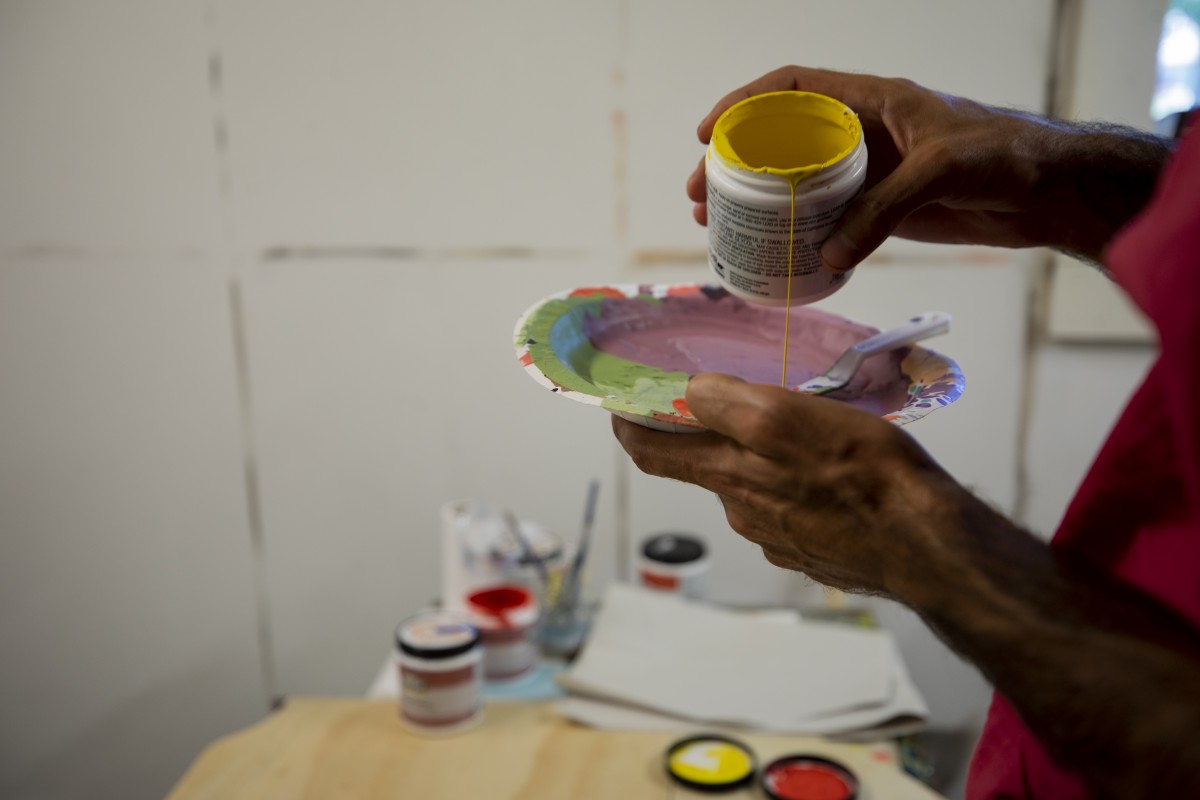During his first week at Chautauqua’s School of Art, Mustafa Yasar started thinking about what he and his family would be doing if he was a kid four thousand years ago.
Yasar figured his father would probably be out hunting most of the time, and his mother would be at home with him and his siblings. He figured he’d have to venture out of the cave they’d live in and be creative with figuring out hobbies. He figured he’d play with rocks.
So Yasar, 32, began painting rocks, then pieces of clay, and placing them in formations outside Bellinger Hall and the School of Art. Over time, he added sticks and fabric to the pieces. He jokingly refers to himself as the school’s “rock star.”
Before leaving this week, Yasar had a corner studio in the School of Art, tucked behind a group of painters’ spaces. A student at Queens College in New York, he works with a variety of different mediums.
“Working in a small space can give you the chance to focus on a single thing, but you become a single-minded person when you work on a single thing,” Yasar said. “I want to work on sculpture at the same time as drawing, drawing at the same time as painting.”
Considering his place in time and what his life would be like as a child thousands of years ago has taught Yasar a lot about human nature and history, he said. The notion has also led him to think about Children’s School and how schools in the United States are structured in general.
Yasar believes children should spend more time outside, exploring the natural environments around them, and less time playing indoors with manufactured toys.
“Nature teaches you how to be free, how to be creative, how to be open-minded,” Yasar said. “So, this was something I did unintentionally, and then these are the things I have learned from the piece.”
He said he wonders how keeping children fenced in at schools and playgrounds, even if it’s for their own safety, may be affecting them. Growing up in Turkey, Yasar and his classmates were mostly allowed free rein, which he thinks influenced him to be more creative later in life.
“I’m not saying (fences) are not necessary,” Yasar said, “but this should be something that we think about.”
Inside his studio, Yasar worked for most of the summer on a piece called “Turkish Cookies.” The “cookies” are pieces of clay that he paints with varying color schemes and are meant to draw attention to women who were arrested in Turkey several months ago for baking cookies for imprisoned students.
When he saw the story in the news, the women reminded Yasar of his own mother. Making dough and clay, he realized, is a similar process: you knead both materials before separating them into smaller pieces and baking them.
Yasar was also responsible for the“School of Cool Guys” sign on Hedding that pointed to the School of Art. A music student approached Yasar and a group of other art students one day at the beginning of the summer and told them, “You guys are so cool.”
While Yasar said he wouldn’t call himself “cool,” personally, he liked the idea for a School of Art sign. He painted it then placed painted red, blue and yellow rocks on it, as he’s become synonymous with the medium.
“I have to respect (the grounds), but at the same time, I’m not damaging public property or trying to harm anybody by doing this,” Yasar said.
Around the same time, Yasar began placing painted rocks around the Arts Quad; he did the same thing outside Bellinger Hall. After a week or two, he said, some students started leaving notes on the bottoms of the rocks, like one that read: “Getting to know the world a little bit at a time.”
Yasar’s pieces outside the School of Art and Bellinger were “unintentional,” he said — simply products of him toying with the idea of living millennia ago. But, he said, it taught him something about human nature.
“Four thousand years ago, I would do the same thing,” Yasar said. “We don’t change.”











